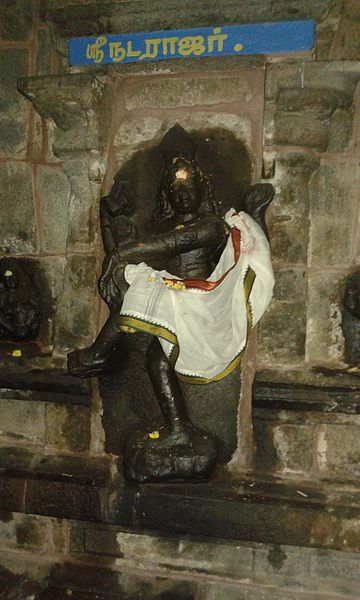Tiruvalanchuzhi Valanchuzhinathar Temple, Swamimalai –
The Temple
The
temple faces east with a majestic five tiered gopuram. As you enter you can see
the beautiful temple tank called Jada theertham. The temple is a beautiful one,
and has several interesting idols on the circumambulatory path. One such idol
is that of Ganga Visarjaneshwarar, depicting Shiva holding Ganga.
The
beautiful tower of the temple is facing east. Ambica graces the
devotees in her wedding posture on the right side. There are several
interesting sculptural features in this vast temple. Inscriptions reveal that
Raja Raja Cholan had made several endowments here. There are also inscriptions
from the period of Parantaka Chola I.
In the
outer Praharam is a sanctum dedicated to the goddess with 8 arms, known as
Ashtabhuja Mahakali. She is believed to be the patron deity of Raja Raja
Chozhan, who prayed to her before setting out for any war. It is she who is
believed to have blessed him; because of divine blessing he never suffered a
defeat in his lifetime. Mother Ashta Bhuja Kali, very furious earlier appears
with a minute damage (in the idol) to calm down her anger, it is
said. There is a separate shrine for Sani Bhagwan.
There
are lots of quotes in the history about the sculptures of this temple. There is
a huge window like structure carved out of a single stone which is facing Lord
Ganesha. It is said that we also have to get the Dharshan of Lord Ganesha
through this window. It is said that the ancient sculptors, when they approach
the Kings to demonstrate their skills and to get an opportunity to work for the
kings, they used to tell the king that except the window of Thiruvalanchuzhi
temple, they can do any kind of sculpture.
Another
interesting factor is that in the sanctum of Kabartheeswarar, we can see Suryan
(Sun) and Shani (Saturn) are facing each other which is very rare. Thiruvalanchuzhi
known in Purana as Swetha Vignesa Puram is in Tamil Nadu and other nine being
in North India in Maharashtra and Uttar Pradesh.
The temple
has five prakarams and the pillars are a treasure trove of sculptures. Brahma
and Indra worshipped the deity here. Since Bhairavar plucked the Brahma’s head
he was cursed with Brahmahatthi dosham. Bhairavar was redeemed of the curse
after taking a bath in the tank and worshipping Vinayaka.
Other Shrines:
Swetha Vinayagar Temple & Bhairava shrine are found in this temple premises. The
presence of Buddhist images from the Chola period in the temple show influence
of Buddhist tradition in the region.
The
temple is renowned for its shrine dedicated to Ganesha (Vinayagar,
Vinayaka). The idol of Vinayaka is white in colour and is believed to have
been created out of sea sand. Hence, the temple is also known as Swetha
Vinayagar Temple in Sanskrit or Vellai Vinayakar Temple in Tamil, meaning
"the temple of the white Vinayaka".
According
to popular legend, Indra, the king of the Devas created the idol of Ganesha out of sea sand during
the churning of the ocean and left it in a niche in the temple hoping to get
back the idol sometime later. But later, when he returned to remove the
idol of Ganesha, it would not budge. So, the idol was allowed to remain where
it was. A lattice-worked stone window pane called palahani is
present in the temple. The temple is originally believed to have been
built by Kanaka Chola in prehistoric times.
The Swetha
Vinayagar Temple (Vellai Vinayakar) is situated in the village
of Thiruvalanchuzhi four kilometres from Kumbakonam
near Swamimalai. The presiding deity is Kapardiswarar, with Ambal Brihannayaki.
Though the Moolavar is Kapardiswarar the importance here is for Ganesha, known
as Swetha Vinayagar.
The
sanctum where Swetha Vinayagar presides is beautifully architected in granite
with intricate works. The entrance on both its sides has large panes carved out
of stones (could be granite or some soft granite like stone).
The
Swetha Vinayagar idol is pure white and is placed in a silver and gold mandapa.
No Abhisheka or flowers are offered to the deity, obviously as the idol is made
up of soft white foam like material. Every decoration and splendour is for the
surrounding frames alone. The only offering is Pachai Karpooram (Borneal Flakes
- edible form of camphor derived from plants and extensively used in sweets),
which is finely crushed and sprinkled over the idol.
The
stone pane in front of Swetha Vinayagar is called as 'Karungal Palagani' (Stone
window) which is beautifully carved and has four pillars and hundred and eleven
holes. This has many religious and spiritual meanings which is beyond the scope
of writing. It is said whenever Kanchi Maha swami (Paramacharyal) used to visit
this temple he used to sit beside this Karungal Palagani and admire its beauty
each time.
The
mandapam next to the sanctum is called Gayathri Mandapam, with 24 beautifully
carved pillars with intricate designs, depicting the 24 akshars of the Gayathri
manthram. It is believed that sitting in this mandapam and chanting Ganesha Gayathri
mantra will bring you relief from all the difficulties in the life, and you
will be blessed by Ganesha with all prosperity.
According
to Puranas (epics), there are ten important abodes for Ganesha in India.
·
Swetha
Vignesa Puram
·
Mayuresa
Puram
·
Raja
Sadhanam
·
Kandageepuram
·
Sidhasramam
·
Bowmapuram
·
Manipuram
·
Kasi
(Varanasi)
·
Chintamani
Puram
·
Prayagai































